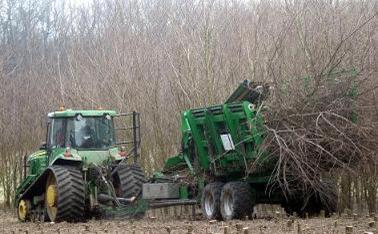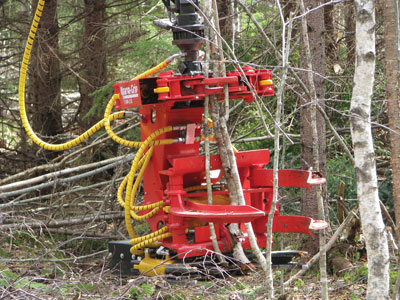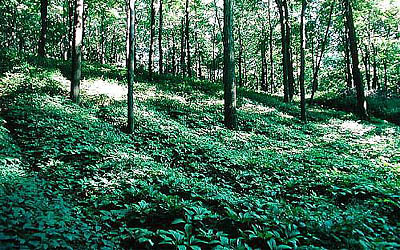*****************
 |
| Tree planting, Northumberland County, 1930 (Image: http://www.northumberlandcounty.ca/) |
While many such woodlots were merely selectively cut native forest, as early as the 1910s the government of Ontario began subsidizing and encouraging the establishment of tree plantations on farmland to prevent erosion and desertification. Such tree plantations could be established on land otherwise unsuitable for farming, and provided higher yield and higher quality lumber than unmanaged woodlots and were often used in multigenerational rotation with pastures after clearcutting. This system had very significant benefits - both economically as on off-season supply of income and ecologically in preventing dessication of both farmland and riparian land, as noted by an Ontario Department of Agriculture report on reforestation in 1908:
"The policy of putting these lands under forest management has many arguments in its favour. It will pay as a financial investment; assist in insuring a wood supply; protect the headwaters of streams; provide breeding ground for wild game, provide object lessons in forestry, and prevent citizens from developing under conditions which can end only in failure."
However, times have changed. Farmers no longer primarily rely on wood for heat given the affordability and availability of fossil fuel heating, they no longer fell trees for their own building lumber given the quality and availability of bought lumber and the increasing popularity of non-wood structures on farms, and the lumber trade has slowly died, with prices being too low to interest most farmers. Tree plantations, which take 2-3 decades before any return can be realized, are now mostly the domain of dedicated logging businesses or are established as permanent windbreaks with no direct value returned to farmers.
 |
| A 140MW generating station in Vaasa, Finland powered by a mix of forestry waste and dedicated energy wood produced by farmers (Image: http://www.power-technology.com/) |
In Europe, however, farmland is a precious and limited resource. Turning over farmland to a crop which will only yield once every 20-30 years is infeasible given the price received by farmers for chipped wood fuel. European farmers have instead had to refine woodlot management techniques that produce significant amounts of woody biomass on a short rotation. These techniques, now known as Short Rotation Forestry (SRF) and Short Rotation Coppice (SRC), mainly supply large generating facilities in Europe. Eslewhere in the world, the mixing of tree plantations of cropland, known as Agroforestry is a popular system for the production of energy wood. Here in Canada though these techniques are mainly of interest for the on-farm generation of heat and/or electricity, especially here in Ontario given the economically lucrative Feed in Tariff system.
Short Rotation Forestry
 |
| 7 year old hybrid white willow (Image: http://silvanusforestry.com/) |
Short Rotation Coppice
 |
| Coppice sprouting from a willow stool (Image: http://www.willowbasketmaker.com/) |
While the woody biomass produced in SRC far outyields SRF to the acre, harvest is a challenge. Harvest of coppice is a tedious task that can only be done in the short period between complete leaf loss (and thus beginning of dormancy) for the tree and the first major snowfall, typically November to early December. While small plantations can get away with hand harvest, larger plantations use a variety of different mechanized harvest systems:
 |
| New Holland forage harvester with 130FB coppice header (Image: www.wnif.co.uk) |
 |
| Salixab coppice billet harvester (Image: http://agroenergie.ca/) |
 |
| Anderson BioBaler (Image: http://www.landwirt.com/) |
 |
| NB Stemster Mk III Harvester (Image: http://www.nordicbiomass.dk/) |
The second is a trailed harvester which can be hauled by a 75hp tractor manufactured in Denmark that cuts the coppice and lays it into a trailer, this trailer can then eject the pile of willow once full. Though the BioBaler system is the more productive of the two, the high-power tractor requirement may be a barrier to most interested producers, and the equipment to shred the biobales will need to be larger (and more costly) than a smaller wood chipper sufficient for the Danish system. The Danish system is also preferable for those doing longer rotations (3+ years) as it can handle thicker coppice than other
harvesters. Another similar piece of equipment is Weremczuk Aronia Cutter
 |
| Weremczuk Aronia Cutter (Image: http://aroniaharvest.com/) |
 |
| Naava Grip 1500 25-E Feller-Buncher (Image: http://www.canadianbiomassmagazine.ca/) |
Agroforestry
 |
| Ginseng among a tree plantation in Maryland (Image: http://www.hardingsginsengfarm.com/) |
Both SRF and SRC systems can be integrated with field crop production for mixed-use farming known as "agroforestry" instead of dedicating land to biomass production alone. Tree plantation strips within a field provide natural windbreaks that generate economic value while preventing erosion, particularly important for those of us with erosion prone sandy or muck soils. Tree plantations also provide shade to crops which require it, which would otherwise require costly artificial netting. Agroforestry may be of particular interest to ginseng producers due to the shade produced and the fact that ginseng is produced on a similar rotation length to SRC and SRF.
Another use for coppice plantations is as pasture for sheep. In England, traditional coppice plantations for basketry are usually stocked with sheep to "clean" the plantation of any grassy overgrowth before harvest. And the coppice is of benefit to the pasture too - in poorly drained or compacted clay and muck soils the deep tree roots can help improve the productivity of pasture. As well, nitrogen fixation by the pasture and manure from the sheep acts as a natural fertilizer to a plantation. Establishing an enclosed wide-row coppice plantation stocked with sheep can help add value to otherwise low-productivity land.
Another use for coppice plantations is as pasture for sheep. In England, traditional coppice plantations for basketry are usually stocked with sheep to "clean" the plantation of any grassy overgrowth before harvest. And the coppice is of benefit to the pasture too - in poorly drained or compacted clay and muck soils the deep tree roots can help improve the productivity of pasture. As well, nitrogen fixation by the pasture and manure from the sheep acts as a natural fertilizer to a plantation. Establishing an enclosed wide-row coppice plantation stocked with sheep can help add value to otherwise low-productivity land.
*****************
While tree plantations are a major source of on-farm bioenergy, they are not the only one. In later articles we will explore agricultural byproducts for energy use as well as dedicated energy crops, and how to turn all of it into environmentally-friendly cost-savings and even cash profit for your farm.



